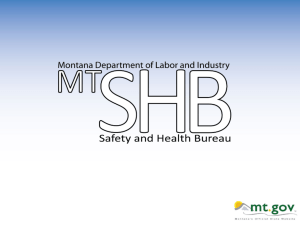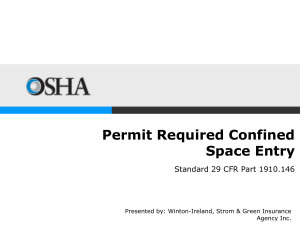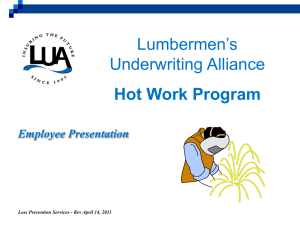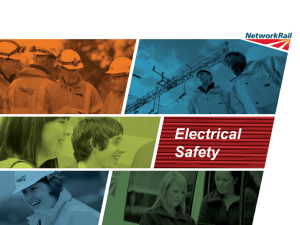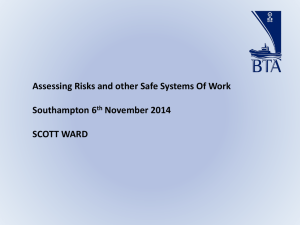Confined Space - Fairmont Specialty
advertisement
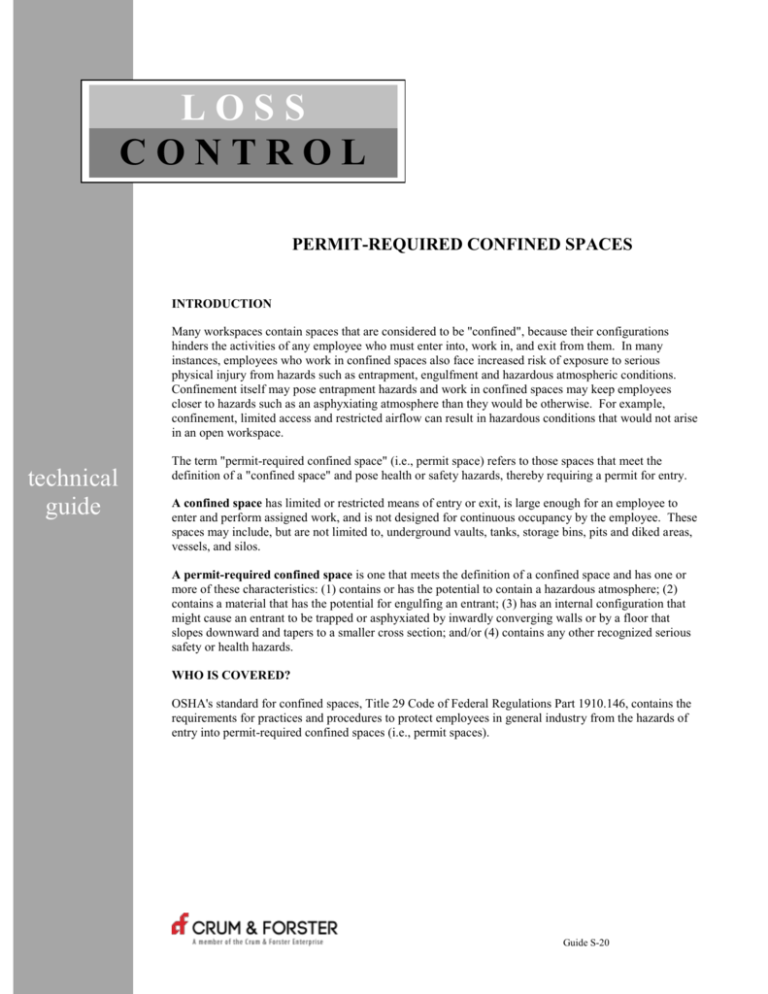
LOSS CONTROL PERMIT-REQUIRED CONFINED SPACES INTRODUCTION Many workspaces contain spaces that are considered to be "confined", because their configurations hinders the activities of any employee who must enter into, work in, and exit from them. In many instances, employees who work in confined spaces also face increased risk of exposure to serious physical injury from hazards such as entrapment, engulfment and hazardous atmospheric conditions. Confinement itself may pose entrapment hazards and work in confined spaces may keep employees closer to hazards such as an asphyxiating atmosphere than they would be otherwise. For example, confinement, limited access and restricted airflow can result in hazardous conditions that would not arise in an open workspace. technical guide The term "permit-required confined space" (i.e., permit space) refers to those spaces that meet the definition of a "confined space" and pose health or safety hazards, thereby requiring a permit for entry. A confined space has limited or restricted means of entry or exit, is large enough for an employee to enter and perform assigned work, and is not designed for continuous occupancy by the employee. These spaces may include, but are not limited to, underground vaults, tanks, storage bins, pits and diked areas, vessels, and silos. A permit-required confined space is one that meets the definition of a confined space and has one or more of these characteristics: (1) contains or has the potential to contain a hazardous atmosphere; (2) contains a material that has the potential for engulfing an entrant; (3) has an internal configuration that might cause an entrant to be trapped or asphyxiated by inwardly converging walls or by a floor that slopes downward and tapers to a smaller cross section; and/or (4) contains any other recognized serious safety or health hazards. WHO IS COVERED? OSHA's standard for confined spaces, Title 29 Code of Federal Regulations Part 1910.146, contains the requirements for practices and procedures to protect employees in general industry from the hazards of entry into permit-required confined spaces (i.e., permit spaces). Guide S-20 . REQUIREMENTS OF THE STANDARD General In general, employers must evaluate the workplace to determine if spaces are permit-required confined spaces. (See flow chart). If there are permit spaces in the workplace, the employer must inform exposed employees of the existence, location, and danger posed by the spaces. This can be accomplished by posting danger signs or by another equally effective means. The following language would satisfy the requirements for such a sign: DANGER - PERMIT REQUIRED-CONFINED SPACE AUTHORIZED ENTRANTS ONLY If employees are to enter permit spaces, the employer must develop a written permit space program which shall be made available to employees or their representatives. Under certain conditions, the employer may use alternative procedures for worker entry into permit space. For example, if employers can demonstrate with monitoring and inspection data that the only hazard is an actual or potential hazardous atmosphere, which can be made safe for entry by the use of continuous forced air ventilation alone, they may be exempted from some requirements such as permits and attendants. Even in such circumstances, however, the internal atmosphere of the space must be tested first for oxygen content, second for flammable gases and vapors, and third for potential toxic air contaminants before any employee enters. Written Program The employer who allows employee entry must develop and implement a written program for permit-required confined spaces. Among other things, the OSHA standard requires the employer's program to: identify and evaluate permit space hazards before allowing employee entry; test conditions in the permit space before entry operations and monitor the space during entry; perform, in the following sequence, appropriate testing for atmospheric hazards: oxygen, combustible gases or vapors, and toxic gases or vapors; implement necessary measures to prevent unauthorized entry; establish and implement the means, procedures, and practices such as specifying acceptable entry conditions; isolating the permit space; providing barriers; verifying acceptable entry conditions; purging; making inert; flushing or ventilating the permit space; to eliminate or control hazards necessary for safe permit-space entry operations; identify employee job duties; provide, maintain, and require, at no cost to the employee, the use of personal protective equipment and any other equipment necessary for safe entry (e.g., testing, monitoring, ventilating, communications, and lighting equipment; barriers, shields, and ladders); Guide S-20 ensure that at least one attendant is stationed outside the permit space for the duration of the entry operations; coordinate entry operations when employees of more than one employer are to be working in the permit space; implement appropriate procedures for summoning rescue and emergency services; establish, in writing, and implement a system for the preparation, issuance, use, and cancellation of entry permits; review established entry operations, and annually revise the permit-space entry program; when an attendant is required o monitor multiple spaces, implement the procedure to be followed during an emergency in one or more of the permit spaces being monitored. If hazardous conditions are detected during entry, employees must immediately leave the space, and the employer must evaluate the space to determine the cause of the hazardous atmospheres. When entry to permit spaces is prohibited, the employer must take effective measures to prevent unauthorized entry. Non-permit confined spaces must be reevaluated when there are changes in their use or configuration and, where appropriate, must be reclassified. If testing and inspection data prove that a permit-required confined space no longer poses hazards, that space may be reclassified as a non-permit confined space. If entry is required to eliminate hazards and obtain the data, the employer must follow procedures as set forth under sections (d) through (k) of the standard. A certificate documenting the data must be made available to employees entering the space. The certificate must include the date, location of the space, and the signature of the person making the certification. Contractors also must be informed of permit spaces and permit space entry requirements, any identified hazards, the employer's experience with the space (i.e., the knowledge of hazardous conditions), and precautions or procedures to be followed when in or near permit space. When employees of more than one employer are conducting entry operations, the affected employers must coordinate entry operations to ensure that affected employees are appropriately protected from permit space hazards. Contractors also must be given any other pertinent information regarding hazards and operations in permit spaces and be debriefed at the conclusion of entry operations. Permit System A permit, signed by the entry supervisor and verifying that pre-entry preparations have been completed and that space is safe to enter, must be posted at entrances or otherwise made available to entrants before they enter a permit space. The duration of entry permits must not exceed the time required to complete the assignment. Also, the entry supervisor must terminate entry and cancel permits when an assignment has been completed or when new conditions exist. New conditions must be noted on the canceled permit and used in revising the permit space program. The standard also requires the employer to keep all canceled permits for at least 1 year. Guide S-20 Entry Permits Entry permits must include the following information: test results tester's initials or signature name and signature of supervisor who authorizes entry name of permit space to be entered, authorized (entrant(s); eligible attendants and individual(s) authorized to be entry supervisors); purpose of entry and known space hazards; measures to be taken to isolate permit spaces and to eliminate or control space hazards i.e., locking out or tagging of equipment and procedures for purging, making inert, ventilating, and flushing permit spaces; name and telephone numbers of rescue and emergency services; date and authorized duration of entry; acceptable entry conditions; communication procedure and equipment to maintain contact during entry; additional permit(s) such as for hot work that have been issued to authorize work in the permit space; special equipment and procedures, including personal protective equipment and alarm system; and any other information needed to ensure employee safety. Training and Education Before initial assignment begins, the employer must provide proper training for all workers who are required to work in permit spaces. Upon completing this training, employers must ensure that employees have acquired the understanding, knowledge, and skills necessary for the safe performance of their duties. Additional training is required when (1) the job duties change; (2) there is a change in the permit-space program or the permit space operation presents a new hazard; and (3) when an employee's job performance shows deficiencies. Training also is required for rescue team members, including cardiopulmonary resuscitation (CPR) and first-aid training . Employers must certify that training has been accomplished. Upon completion of training, employees must receive a certificate of training that includes the employee's name, signature or initials of trainer(s), and dates of training. The certification must be made available for inspection by employees and their authorized representatives. In addition, the employer also must ensure that employees are trained in their assigned duties. Guide S-20 Authorized Entrant's Duties Know space hazards, including information on the mode of exposure, e.g., inhalation or dermal absorption), signs or symptoms, and consequences of the exposure; Use appropriate personal equipment properly (e.g., face and eye protection and other forms of barrier protection such as gloves, aprons, and coveralls); As necessary, maintain communication (i.e., telephone, radio, visual observation) with attendants to enable the attendant to monitor the entrant' s status as well as to alert the entrant to evacuate; Exit from permit space as soon as possible when ordered by an authorized person; when the entrant recognizes the warning sign or symptoms of exposure exist; when a prohibited condition exists; or when an automatic alarm is activated; and Alert the attendant when a prohibited condition exists or when warning signs of symptoms of exposure exist. Attendant's Duties Remain outside permit space during entry operations unless relieved by another authorized person; Perform non-entry rescues when specified by employer's rescue procedure; Maintain communication with and keep an accurate account of those workers entering the permit-required space; Know existing and potential hazards, including information on the mode of exposure, signs or symptoms, consequences of the exposure, and its physiological effects; Maintain communication with and keep an accurate account of those workers entering the permit-required space; Order evacuation of the permit space when a prohibited condition exists; when a worker shows signs of physiological effects of hazard exposure; when an emergency outside the confined space exists; and when the attendant cannot effectively and safely perform required duties. Summon rescue and other services during an emergency; Ensure that unauthorized persons stay away from permit spaces or exit immediately if they have entered the permit space; Inform authorized entrants and entry supervisor of entry by unauthorized persons; and Ensure that entry operations remain consistent with the entry permit and that acceptable entry conditions are maintained. Guide S-20 Emergencies The standard requires the employer to ensure that rescue service personnel are provided with and trained in the proper use of personal protective and rescue equipment, including respirators; trained to perform assigned rescue duties; and have had authorized entrants training. The standard also requires that all rescuers be trained in first aid and CPR and, at a minimum, one rescue team member be currently certified in first aid and CPR. The employer must ensure that practice rescue exercises are performed yearly, and that rescue services are provided access to permit spaces so that they can practice rescue operations. Rescuers also must be informed of the hazards of the permit space. Also, where appropriate, authorized entrants who enter a permit space must wear a chest or full body harness with a retrieval line attached to the center of their backs near shoulder level or above their heads. Wristlets may be used if the employer can demonstrate that the use of a chest or full body harness is not feasible or creates a greater hazard. Also, the employer must ensure that the other end of the retrieval line is attached to a mechanical device or to a fixed point outside the permit space. A mechanical device must be available to retrieve personnel from vertical type permit spaces more than 5 feet deep. In addition, if an injured entrant is exposed to a substance for which a material Safety Data Sheet (MSDS) or other similar written information is required to be kept at the worksite, that MSDA or other written information must be made available to the medical facility treating the exposed entrant. PROCEDURES OF ATMOSPHERIC TESTING IN CONFINED SPACES1 Atmospheric testing is required for two distinct purposes: evaluation of the hazards of the permit space and verification that acceptable conditions exist for entry into that space. (1) Evaluation testing. The atmosphere of a confined space should be analyzed using equipment of sufficient sensitivity and specificity to identify and evaluate any hazardous atmospheres that may exist or arise, so that appropriate permit entry procedures can be developed and acceptable entry conditions stipulated for that space. Evaluation and interpretation of these data and development of the entry procedure should be done by, or reviewed by, a technically qualified professional (e.g., OSHA consultation service or certified industrial hygienist, registered safety engineer, certified safety professional) based on evaluation of all serious hazards. (2) Verification testing. The atmosphere of a permit space which may contain a hazardous atmosphere should be tested for residues of all contaminants identified by evaluation testing using permit specified equipment to determine that residual concentrations at the time of testing and entry are within the range of acceptable entry conditions. Testing order should be oxygen, flammables, and then toxics2. Results of testing (i.e., actual concentration) should be recorded on the permit in the space provided adjacent to the stipulated acceptable entry condition. (3) Duration of testing. Measurement of values for each atmospheric parameter should be made for at least the minimum response time of the test instrument specified by the manufacturer. (4) Testing stratified atmospheres. When monitoring for entries involving a descent into atmospheres which may be stratified, the atmospheric envelop should be tested a distance of approximately four (4) feet (2.22 meters) in the direction of travel and each side. If a sampling probe is used, the entrant's rate of progress should be slowed to accommodate the sampling speed and detector response. This information has been developed from sources believed to be reliable. However, since it is a general guide to safety, compliance with all federal, state or local laws and regulations is the policyholder’s responsibility. Guide S-20

